
A bogie is a chassis or framework that carries a wheelset, attached to a vehicle—a modular subassembly of wheels and axles. Bogies take various forms in various modes of transport. A bogie may remain normally attached or be quickly detachable ; it may contain a suspension within it, or be solid and in turn be suspended ; it may be mounted on a swivel, as traditionally on a railway carriage or locomotive, additionally jointed and sprung, or held in place by other means.

A cowcatcher, also known as a pilot, is the device mounted at the front of a locomotive to deflect obstacles on the track that might otherwise damage or derail it or the train.
As used in mechanical engineering, the term tractive force can either refer to the total traction a vehicle exerts on a surface, or the amount of the total traction that is parallel to the direction of motion.

The Watercress Line is the marketing name of the Mid-Hants Railway, a heritage railway in Hampshire, England, running 10 miles (16 km) from New Alresford to Alton where it connects to the National Rail network. The line gained its popular name in the days when it was used to transport locally grown watercress to markets in London. The railway currently operates regular scheduled services, along with dining trains, real ale trains and numerous special events throughout the year.

This article is a glossary of the main components found on a typical steam locomotive.

A traction motor is an electric motor used for propulsion of a vehicle, such as locomotives, electric or hydrogen vehicles, or electric multiple unit trains.
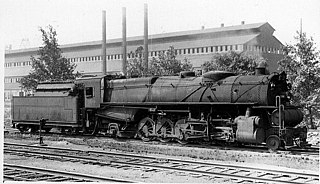
The Pennsylvania Railroad's N1s was a class of steam locomotive built for Lines West. They were of 2-10-2 "Santa Fe" wheel arrangement, ten driving wheels with a two-wheel leading truck and a two-wheel cast KW-pattern trailing truck under a giant firebox. This arrangement was well suited to the N1s' intended purpose, which was as a heavy drag freight engine for coal and iron ore traffic to and from lakeside ports. The design was developed by the PRR's Fort Wayne Shops and orders were placed with Alco (Brooks) and Baldwin for a total of 60; the first Alco locomotive was delivered in December 1918, with the remainder arriving during 1919.

A drag freight is a long, slow, high-tonnage railroad train, often carrying commodities such as coal or ore. Compared to "fast freight" trains, drag freight trains have a very low power-to-weight ratio, making them somewhat unpredictable on steep grades or hilly routes. This causes many dispatchers to be extremely conservative with how they handle drag freights, especially when they share lines with higher priority fast freights and passenger trains.
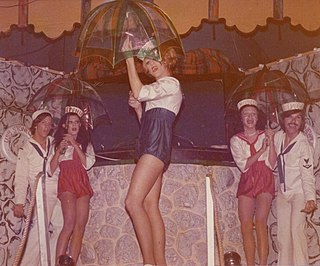
A drag show is a form of entertainment performed by drag artists impersonating men or women, typically in a bar or nightclub. Shows can range from burlesque-style, adult themed nightclub acts to all-ages events with sing-alongs and story times.

EP02 is a name for a Polish electric locomotive. It was made for passenger transport purposes.

Salamanca was the first commercially successful steam locomotive, built in 1812 by Matthew Murray of Holbeck, for the edge-railed Middleton Railway between Middleton and Leeds, England and it predated Stephenson's Rocket by 17 years. It was the first to have two cylinders. It was named after the Duke of Wellington's victory at the battle of Salamanca which was fought that same year.
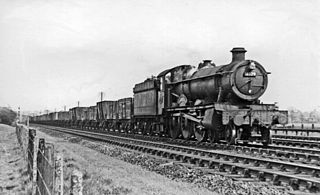
GWR 4900 Class 4-6-0 No. 4979 Wootton Hall is a steam locomotive. It was built at Swindon, February 1930, and was one of 258 Hall class steam locomotives constructed.

The Renfe Series 333 are high power six-axle diesel-electric locomotives built in the 1970s; at the time of their introduction they were the most powerful non-electric locomotives in Spain.

Locomotive 3526 is a two-cylinder, simple, non-condensing, coal-fired superheated, 4-6-0 New South Wales C35 class locomotive express passenger steam locomotive. The only C35 class left in existence, and is operational. The class is commonly referred to as Nannies or Naughty Nannies due to their pre-1924 class designation of NN.
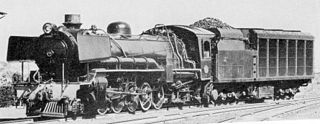
The South African Railways Class 20 2-10-2 of 1935 was a steam locomotive.

The South African Railways Class 19C 4-8-2 of 1935 was a steam locomotive.

The South African Railways Class 6L 4-6-0 of 1904 was a steam locomotive from the pre-Union era in the Cape of Good Hope.

The South African Railways Class 5B 4-6-2 of 1904 was a steam locomotive from the pre-Union era in the Cape of Good Hope.
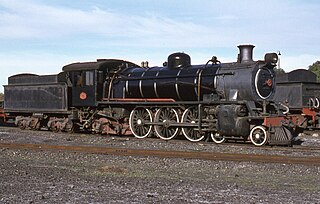
The South African Railways Class 5 4-6-2 of 1912 was a steam locomotive.

The Natal Government Railways 4-6-2TT Havelock of 1888 was a South African steam locomotive from the pre-Union era in the Natal Colony.


















